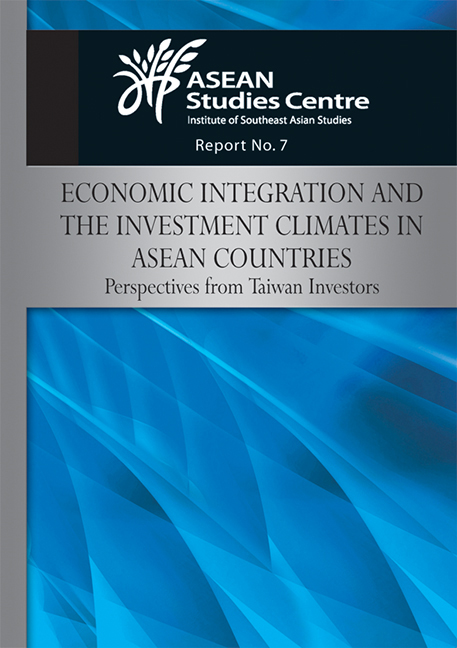 Economic Integration and the Investment Climates in ASEAN Countries
Economic Integration and the Investment Climates in ASEAN Countries from I - Economic Integration and the Investment Climates in ASEAN Countries: Perspectives from Taiwan Investors
Published online by Cambridge University Press: 21 October 2015
50. Dr Michael Hsiao concluded by saying that for ASEAN-Taiwan relations, there existed many issues from both the research and political angles. However, for now the focus was on ASEAN economic integration and how it might affect the Taiwanese business people in the long run. While this symposium had taken a first step by raising the awareness of a small group of people, more needed to be discussed in the future.
51. Mr Rodolfo Severino gave a few policy suggestions: (1) To strengthen ASEAN-Taiwan relations, a Taiwan-ASEAN business council could be formed among Taiwanese companies doing business in ASEAN. Although many small and medium enterprises might not be ready for this, it could help ASEAN to shape trade and investment policies that would be more favourable to Taiwanese investors. It might also push domestic reforms in ASEAN countries. (2) ASEAN might also need to upgrade or change its educational system so as to fit the needs of the Taiwanese manufacturing sector in the region. Moreover, the education of Taiwanese children in ASEAN should be given important consideration. (3) ASEAN also needed to provide appropriate medical facilities for migrant Taiwanese workers. (4) There were also some gaps in research in areas such as studies on the social situation of Taishang in ASEAN countries. (5) Information from ASEAN countries was needed in terms of infrastructure, labour laws, taxation policy, etc. This information should be available in Chinese, as many Taiwanese investors had limited grasp of the English language.
52. Mr Severino suggested some themes for future symposiums. A survey had been done by a Taiwanese institute on Taishang in ASEAN. The findings would be available by the third quarter of 2009. So the next symposium could focus on these findings and could have attendees from the ASEAN Secretariat, Taishang and other knowledgeable people from ASEAN and Taiwan. This could be arranged sometime in late 2009 in Singapore.
53. Dr David Hong from TIER suggested a few other areas that required discussion: (1) labour mobility between ASEAN and Taiwan; (2) ASEAN's production chain and the division of labour; and (3) regional tourism cooperation.
To save this book to your Kindle, first ensure [email protected] is added to your Approved Personal Document E-mail List under your Personal Document Settings on the Manage Your Content and Devices page of your Amazon account. Then enter the ‘name’ part of your Kindle email address below. Find out more about saving to your Kindle.
Note you can select to save to either the @free.kindle.com or @kindle.com variations. ‘@free.kindle.com’ emails are free but can only be saved to your device when it is connected to wi-fi. ‘@kindle.com’ emails can be delivered even when you are not connected to wi-fi, but note that service fees apply.
Find out more about the Kindle Personal Document Service.
To save content items to your account, please confirm that you agree to abide by our usage policies. If this is the first time you use this feature, you will be asked to authorise Cambridge Core to connect with your account. Find out more about saving content to Dropbox.
To save content items to your account, please confirm that you agree to abide by our usage policies. If this is the first time you use this feature, you will be asked to authorise Cambridge Core to connect with your account. Find out more about saving content to Google Drive.